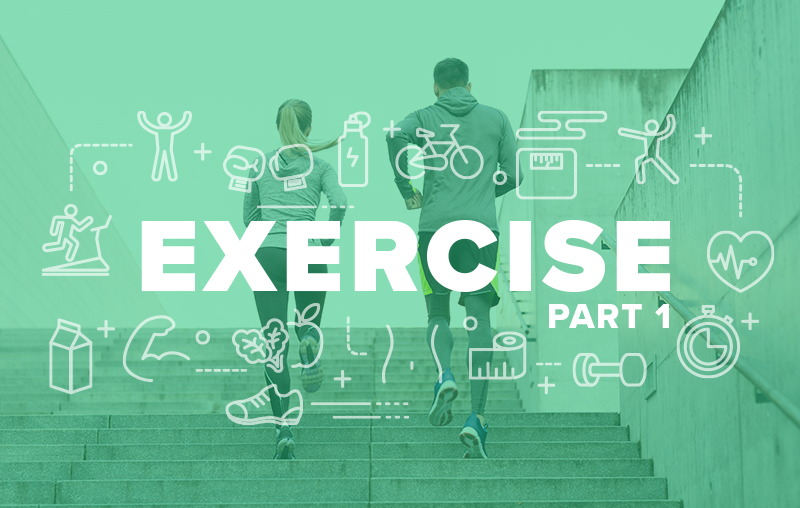Written by Dr. Carl DuCharme
What is exercise?
Exercise is physical activity of moderate to vigorous intensity that has the intention of enhancing or maintaining physical health, fitness and overall well-being. A complete exercise regimen will contain 4 major components:
- Resistance Training
- Aerobic (Cardiovascular) Training
- Flexibility
- Balance
Over the next few weeks, we will explore the role that exercise plays in your health, the specific benefits, types of exercise and the ways to incorporate exercise into your life. The first installment of this 5-part series will focus on the importance of exercise and activity and how to get started.
PART I: EXERCISE AND ACTIVITY
According to the Department of Health and Human Services less than 5% of adults get 30 minutes of activity each day, and only one in three adults receive the recommended amount of moderate physical activity each week of 150 minutes. Not to pile on too much, but did you know only 6 states require physical education in every grade, K-12? It is reported that roughly 1/3 of high school students spend 3 or more hours playing video games each day.
What are the benefits of exercise?
Since the 1950s scientific research has revealed profound health benefits with regular exercise. For example, having low levels of exercise or not exercising at all can increase mortality risk more than smoking or diabetes will. Increasing physical performance is inversely associated with long-term mortality with no observed upper limit of benefit. This means those with elite fitness levels have roughly 80% reduction in mortality.
The more you exercise = the more you benefit.
Even if you have never exercised, studies show becoming active between ages of 41 and 60 can decrease the rate of mortality by 35%. These benefits were seen regardless of body mass index (BMI). Small amounts of exercise even less than 1 hour per week will benefit your health. Moderately exercising for >150 minutes per week has been shown to reduce all-cause, cardiovascular disease-related, and cancer-related mortality.
In 2012, the British Journal of Pharmacology even went as far to publish a review paper with the following conclusion, “exercise is so effective that it should be considered as a drug”. In this review, the authors detailed how exercise promotes health, lifespan and acts as a psychoactive drug in most people to cause a very pronounced relaxing effect.
Exercise has even been shown to have a profound impact on cognition and memory. Regular exercise has been shown to reduce risk of dementia by about 30%. Specifically, the risk reduction for Alzheimer’s disease is even better at 45% reduction. One published study showed regular exercise is far better at reducing risk of dementia than not smoking, eating healthy, keeping ideal bodyweight or limiting alcohol intake to a moderate amount.
I have personally witnessed the power of exercise prescription in my patients. One man even reversed his diabetes in 3 months with exercise! It is part of my routine assessment and plan for each patient. Let’s face the facts, most patients want to get off of medications and avoid them if they can. Exercise can help you do this.
As an added bonus, exercise has anti-inflammatory effects. This helps do many things in the body like boost the immune system, which can help you stay healthy during cold and flu season. Exercise has even been shown to slow the process of aging.
Let’s review the benefits of exercise:
- Increase your lifespan
- Improve your health
- Decrease risk of diabetes, high blood pressure, dementia and some cancers
- Slow the process of aging
- Decrease all-cause mortality
Now that I have your attention, you’re probably saying this sounds too good to be true, I want all of those things and where do I sign up?!
I know! All these statements sound too good to be true. As a physician, I can attest that those patients who have incorporated exercise into their lives have seen several improvements in their health. It all depends on how much exercise they can or are willing to do.
How do I get started exercising?
The simplest way to add more activity and exercise to your life is walking. Walking is free and easy to incorporate into your daily life. Let’s look at the scientific facts about walking and how it relates to increasing health.
A 2014 study showed the benefits of walking are equal to those of running or vigorous activity if the calorie expenditure was the same. Additionally, just the act of walking any amount during the week is associated with lower all-cause mortality compared with inactivity.
Multiple studies have shown that the more you walk each day, the more it lowers all-cause mortality. I should mention that most of these studies look at walking as a moderate-intensity exercise. Therefore, you need to keep a minimum walking speed of 3-4 mph. To ensure that you are keeping a good pace, consider downloading an app that will track not only the total distance and time, but also your speed.
There is an expanding amount of research on interval walking. Interval walking is walking at a very brisk pace for a short burst and then returning to normal paced walking in intervals. These intervals have been shown to be more impactful on lowering blood pressure, lowering blood sugar, improving mood, and burning body fat.
Whether you are currently inactive or walk or run several miles per day; most of us can take this opportunity to improve our health.
PLAN INTO ACTION
For the beginners we want to focus on consistency to build discipline around a routine that is manageable. Start your goal with walking 30 minutes 3 times per week, or for 15 minutes daily. This is just to ease in and develop a habit like brushing your teeth or showering. Once you’ve mastered maintaining the habit of walking you can increase the duration or the frequency per week keeping in mind the more you do it, the more health benefits you will see. There appears to be no upper limit!
If you get bored easily, I recommend you start with interval walking. Short alternating speeds of walking will keep your attention (and give you better health benefits!). Start with a normal walking pace around 100-110 steps per minute or 3 mph for 15 seconds. Then for the next 15 seconds walk much quicker (like you are late for an important meeting) around 130-140 steps per minute or 3.7 mph.
Once your fitness level is improving you can increase the amount of time spent in the quick phase or time spent walking. I recommend documenting your progress on a calendar or in a notebook. Not only does it feel good to write down a finished task, but it will help you stay on track each week to complete the number of days set as your goal.
Stay tuned for Part II where we will explore resistance training and its innumerable benefits.


